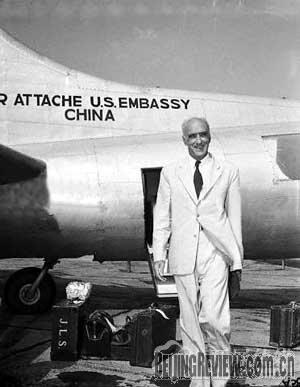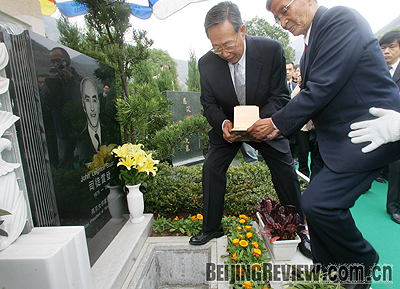|
|

FAREWELL: John Leighton Stuart leaves China for the United States in August 1949 (FILE) | The ashes of John Leighton Stuart (1876-1962), the U.S. ambassador to China from 1946 to 1949, were sent back to China. Stuart has been a household name in China for his appearance in one of Mao Zedong's best-known essays, a must-read for Chinese middle school students for generations.
When the 73-year-old Stuart left China for the United States in August 1949, Washington published the China White Paper, which documented American policy in China over the previous five years. To rebut the paper, Mao wrote the essay entitled Farewell, Leighton Stuart, in which he called Stuart the "symbol of the complete defeat of the U.S. policy of aggression."
Sixty years after Mao bid him farewell and 46 years after his death, Stuart's ashes have finally returned to China. On November 17, 2008, they were laid in a tomb in Hangzhou, capital of east China's Zhejiang Province.
Stuart was born in Hangzhou in 1876 and grew up speaking fluent Chinese and sterling Hangzhou dialect. He moved to the United States with his parents at the age of 11 for an education and returned to China in 1904, becoming a second-generation missionary. Later on, he devoted years to the founding of Yenching University, China's top missionary university, and served as its president. In 1946, he was appointed U.S. Ambassador to China. When the Kuomintang was defeated and retreated to Taiwan in 1949, Stuart was asked to leave.
Stuart died in Washington in 1962 with a wish that his ashes would someday be buried in China. But few could imagine Stuart would ever return at that time, even in ashes.
|

HOMECOMING: General John Fugh (left), Chairman of the Committee of 100, and Jiang Yanzhen, a Yenching University alumnus, place the ashes of John Leighton Stuart inside his tomb in Hangzhou, capital of east China’s Zhejiang Province, on November 17, 2008 (CFP) | Compared with the uproar when Stuart left China last century, his return last November was kept as quiet and low-key as possible by both Chinese and U.S. officials. Stuart's museum in Hangzhou, which organized the interment ceremony, and the Hangzhou Government refused to provide any information about it. The U.S. Embassy also told Beijing Review that no one in the Beijing office had any knowledge of the event, except Ambassador Clark T. Randt, Jr. who attended the ceremony.
A long way back
The recent interment in Hangzhou was made possible mostly by the Fugh family. Philip Fugh was a close aide to Stuart in China and later accompanied him back to the United States. The Fugh family took care of Stuart when he was confined to bed with cerebral thrombosis for his last 13 years and when he was prosecuted by McCarthyism in the 1950s. After Stuart's death, the Fugh family tried for decades to carry out his dying wish.
|
